This website was created by Blaine W. Schubert of East Tennessee State University. For comments and inquiries contact schubert@etsu.edu
What is Cave Paleontology?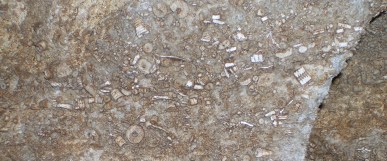
In sum, it is the study of fossils (evidence of past life) from caves. The bedrock in which caves are formed is typically limestone or dolomite. This type of rock developed over millions of years when these regions were covered with shallow seas. Such rocks often contain fossils of organisms that lived and died in these waters.
This photograph of a cave "ceiling" was taken in the depths of a limestone cave in Missouri. These fossils date to about 300 million years ago.
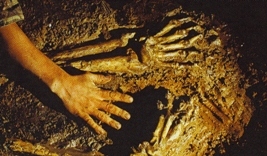 There is another type of "fossil" found in caves. These are the remains and traces of organisms that used the cave, died in it, or were carried in by carnivores, rodents, birds of prey, stream wash, or some other transport mechanism. This website focuses on vertebrate fossils from caves and other karst features.
There is another type of "fossil" found in caves. These are the remains and traces of organisms that used the cave, died in it, or were carried in by carnivores, rodents, birds of prey, stream wash, or some other transport mechanism. This website focuses on vertebrate fossils from caves and other karst features.
The picture to the left is a giant short-faced bear (Arctodus simus) skeleton from an Ozark cave (Missouri). To learn more about the excavation of this specimen click here.
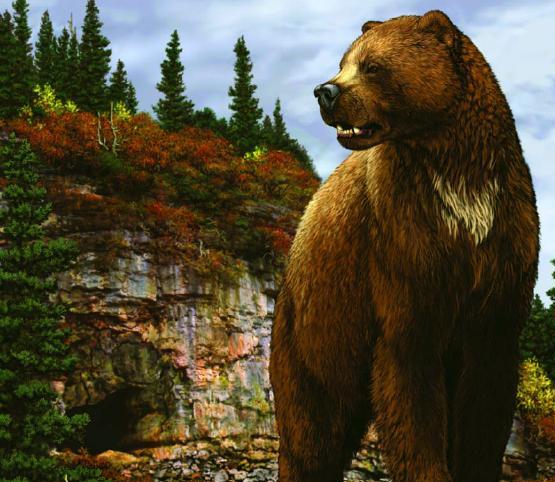
Note: Such finds are rare and irreplaceable. If you happen to be lucky enough to find old bones or tracks in a cave take pictures and notify a cave paleontologist. This person will assist you in assessing the importance of the find. If you need assistance in finding a specialist in your geographic area contact schubert@etsu.edu.
Some giant short-faced bear individuals were extremely large, reaching 5.5 ft. at the shoulders (when on all fours). They were extinct by ~10,000 years ago. This painting of an Arctodus in the Ozarks was done by Natural History artist Carl Dennis Buell. For a larger version of this picture click here.
Why Caves?
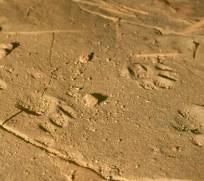
Caves typically have relatively stable environments in terms of temperature and humidity, and are therefore able to preserve the remains of organisms for thousands or even millions of years.
The tracks to the right are in clay and are at least 10,000 years old. They belong to some type of extinct cat (perhaps the American lion, Panthera atrox). Often times records of animals, such as this cat, are found far back in caves. This is usually because the animals entered through an entrance that does not exist anymore. These tracks are from a cave in the Arkansas Ozarks.
Why is this Important?


Skeletal remains in caves are typically Quaternary in age (1.8 million years to present) because surface erosion eventually results in the destruction of caves and their in-filled deposits. In North America, this time period has been a dynamic one, witnessing dramatic climatic fluctuations, numerous glacial advances and retreats, the reorganization of biological communities in response to climate change, the extinction of at least 30 genera of large mammals (e.g., mammoths, mastodons, giant ground sloths, saber tooth cats, extra large armadillos), and the arrival of humans on the continent. Because caves often preserve Quaternary records, they serve as a primary resource for understanding the intricacies of this exciting period.
This map of North America shows the rapid retreat of continental glaciers at the end of the last glaciation (image from the Illinois State Museum's Ice Age website). To learn more click here

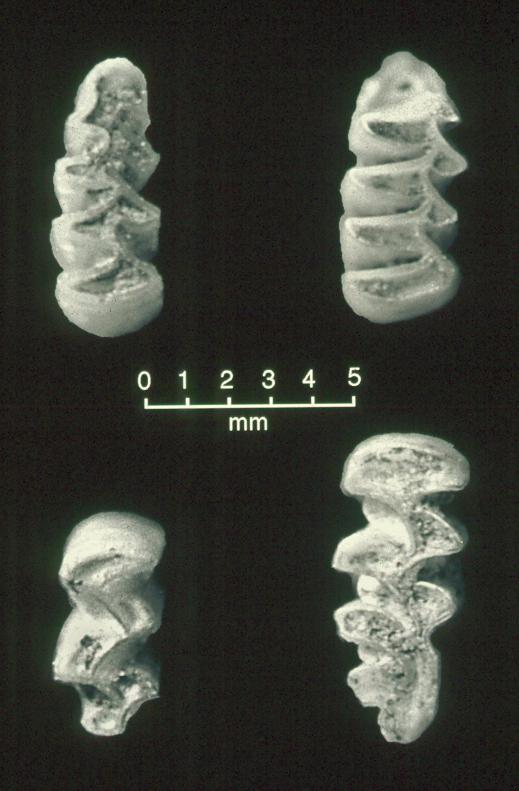 Cave sediments often contain abundant small animal remains. Some of these, particularly micromammals, are important paleoenvironmental indicators. This is because many types of small mammals are very particular about the type of environments they live in and have shifted their ranges in response to climatic changes.
Cave sediments often contain abundant small animal remains. Some of these, particularly micromammals, are important paleoenvironmental indicators. This is because many types of small mammals are very particular about the type of environments they live in and have shifted their ranges in response to climatic changes.Picture "A" is unsorted cave matrix from an Ozark cave. Picture "B" shows vole teeth (same cave) from species that today live far to the north. The yellow-cheeked vole (lower right) only occurs in northern Canada and Alaska today.
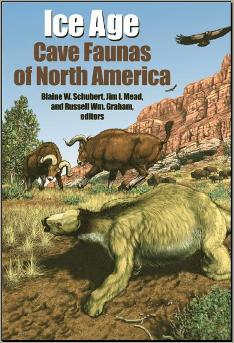
Many animals utilize caves today, and in the past, numerous large mammals that are now extinct used caves for one reason or another. For example, the giant short-faced bear (Arctodus simus) and some types of ground sloths (e.g., Nothrotheriops and Megalonyx) appear to have used caves for denning and possibly torpor. Flat-headed peccaries (Platygonus compressus) frequented caves in groups and some large carnivores (e.g.,Canis dirus, and Homotherium) may have used caves for rearing their young. Undoubtedly, caves provide unique opportunities to learn about the paleobiology of certain extinct species.
A recent book on cave paleontology (shown here) covers
all of the above topics in greater detail. To learn more about this book click here.
As part of the expanding Center of Excellence in Paleontology at East Tennessee State University, a Cave Paleontology Program is now underway. For more information about this program click here.